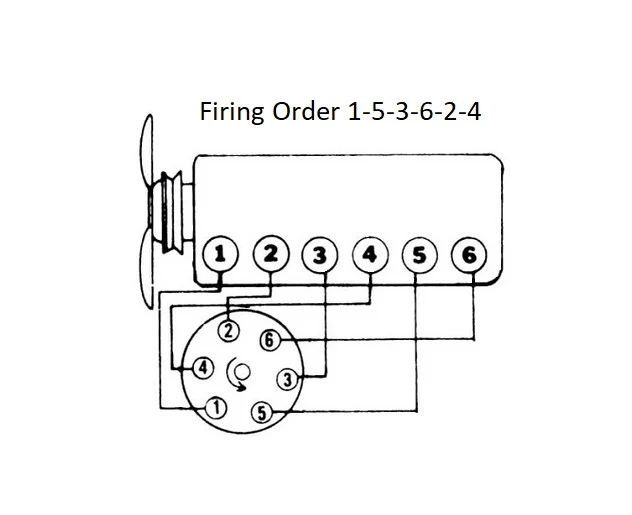The Datsun 260Z, part of Nissan’s iconic Z-car series, is a classic car celebrated for its timeless design and inline-six engine. One of the engine’s most critical aspects is its firing order.
The firing order determines the sequence in which the engine’s cylinders fire, influencing performance, balance, and efficiency.
This guide delves into the Datsun 260Z firing order, explaining its purpose and maintenance in a clear, conversational tone.

Quick Navigation
What is a Firing Order?
The firing order is the sequence in which the engine’s cylinders ignite their air-fuel mixture during the combustion process. For a multi-cylinder engine like the inline-six used in the Datsun 260Z, the firing order ensures balanced operation and smooth power delivery.
The firing order in the Datsun 260Z is 1-5-3-6-2-4. This specific sequence is carefully designed to optimize engine performance and prevent excessive vibration or wear.

Why the Firing Order Matters
The firing order plays a critical role in how the Datsun 260Z engine functions. Here’s why it’s so important:
- Balanced Operation: The firing order ensures that power strokes are evenly distributed across the engine, minimizing vibrations.
- Efficient Power Delivery: Proper sequencing maintains steady torque and horsepower output, providing smooth acceleration.
- Engine Durability: A balanced firing order reduces stress on engine components, preventing premature wear.
- Fuel Efficiency: Correct firing ensures complete combustion, optimizing fuel use.
Without a proper firing order, the engine would struggle to deliver power effectively, resulting in poor performance and potential damage.
The Datsun 260Z Firing Order: 1-5-3-6-2-4
Let’s break down the 260Z’s firing order, 1-5-3-6-2-4, to understand how it works:
- Cylinder 1 Fires: The firing sequence begins with Cylinder 1, where the spark plug ignites the air-fuel mixture during the power stroke.
- Cylinder 5 Follows: Cylinder 5 takes over, maintaining a smooth transition of power.
- Cylinder 3 Fires Next: After Cylinder 5, Cylinder 3 ignites, continuing the sequence.
- Cylinder 6 Engages: Cylinder 6 fires, ensuring the engine remains balanced.
- Cylinder 2 Takes Over: Cylinder 2 ignites, contributing to the power cycle.
- Cylinder 4 Completes the Cycle: The sequence ends with Cylinder 4, and the cycle repeats.
This firing order ensures that the inline-six engine runs smoothly and efficiently. The balanced sequence is significant in the Datsun 260Z, as its performance-oriented design relies on precision.
How the Firing Order Operates in the Engine
The Datsun 260Z features a 2.6-liter inline-six engine that operates on a four-stroke cycle. Each cylinder performs the following strokes:
- Intake Stroke: The intake valve opens, allowing the air-fuel mixture to enter the cylinder.
- Compression Stroke: The piston compresses the mixture, preparing it for combustion.
- Power Stroke: The spark plug ignites the mixture, creating an explosion that drives the piston downward.
- Exhaust Stroke: The exhaust valve opens, releasing the spent gases.
The firing order coordinates these strokes across all six cylinders, ensuring consistent power delivery. The sequence follows the 1-5-3-6-2-4 pattern, balancing the engine’s operation and reducing stress.
Key Components Involved in the Firing Order
The firing order of the Datsun 260Z depends on several components working together seamlessly. These include:
- Crankshaft: Converts the pistons’ linear motion into rotational energy and ensures proper timing for the firing order.
- Camshaft: Controls the timing of the intake and exhaust valves, aligning with the firing sequence.
- Distributor: Routes electrical signals to the spark plugs in the correct firing order.
- Spark Plugs: Ignite the air-fuel mixture in each cylinder at the right time.
- Timing Chain: Ensures synchronization between the crankshaft and camshaft to maintain the firing order.
When these components operate correctly, the firing order is executed flawlessly, resulting in the smooth performance the 260Z is known for.
Symptoms of Firing Order Issues
A disruption in the firing order can lead to noticeable engine problems. Here are some common symptoms:
- Engine Misfires: If one or more cylinders fail to ignite correctly, you may experience power loss or jerking.
- Rough Idling: The engine may run unevenly, especially when idle, due to improper firing.
- Power Loss: An incorrect firing order reduces efficiency, leading to sluggish acceleration.
- Vibrations: Disrupted balance can cause excessive engine vibrations.
- Backfiring: Faulty timing may lead to combustion gases igniting in the intake or exhaust.
Recognizing these signs early can help you address firing order issues before they cause significant damage.
How to Verify the Firing Order
To ensure the Datsun 260Z engine maintains its firing order, follow these steps:
- Inspect the Spark Plug Wires: Ensure the wires are correctly connected to the distributor and the corresponding cylinders.
- Check the Distributor Cap: Verify that the cap is not damaged or misaligned, as this can disrupt the sequence.
- Consult the Service Manual: Use the 260Z’s service manual to reference the correct firing order and wiring diagram.
- Listen for Irregular Sounds: Pay attention to unusual noises like sputtering or popping, which could indicate a firing order problem.
- Use a Timing Light: A timing light can confirm that each spark plug fires at the correct time.
If you encounter issues, consider consulting a mechanic to avoid further complications.
Maintaining the Firing Order
Regular maintenance is crucial to preserving the Datsun 260Z’s firing order. Here are some tips:
- Replace Spark Plugs as Needed: Worn spark plugs can cause misfires and disrupt the firing sequence.
- Inspect the Distributor and Wires: Ensure the wires are properly connected, and the distributor is functioning correctly.
- Check the Timing Chain. A loose or worn timing chain can cause timing issues, which can affect the firing order.
- Perform Regular Tune-Ups: Routine maintenance helps identify potential problems early.
- Use High-Quality Fuel: Clean-burning fuel minimizes carbon buildup, improving combustion efficiency.
Sticking to these practices will keep your engine running smoothly and reliably.
Can You Modify the Firing Order?
Altering the firing order of the Datsun 260Z is not advisable. The engine is designed to work with the 1-5-3-6-2-4 sequence, and changing it could lead to:
- Imbalanced Operation: Disrupting the firing order may cause excessive vibrations.
- Reduced Performance: Modifications can lead to inefficient combustion and power loss.
- Potential Damage: Incorrect changes may harm internal components, leading to costly repairs.
If you’re looking to enhance performance, focus on modifications like intake, exhaust, or ignition system upgrades rather than altering the firing order.
Engines with Similar Firing Orders
- 2014 Nissan Pathfinder Firing Order
- Nissan Murano Firing Order
- Nissan TD42 Firing Order
- Nissan H20 Firing Order
- 2001 Nissan Altima Firing Order
Conclusion
The firing order of the Datsun 260Z, 1-5-3-6-2-4, is a fundamental aspect of its inline-six engine design. It ensures smooth power delivery, efficient combustion, and long-term reliability. By understanding the firing order and its role, you can better appreciate the engineering that makes the 260Z a classic favorite.
Routine maintenance, attention to detail, and timely diagnostics will help you preserve the firing order and enjoy the timeless performance of the Datsun 260Z. Whether you’re restoring one or taking it out for a drive, a well-maintained firing order will ensure your experience is as smooth and exhilarating as intended.

